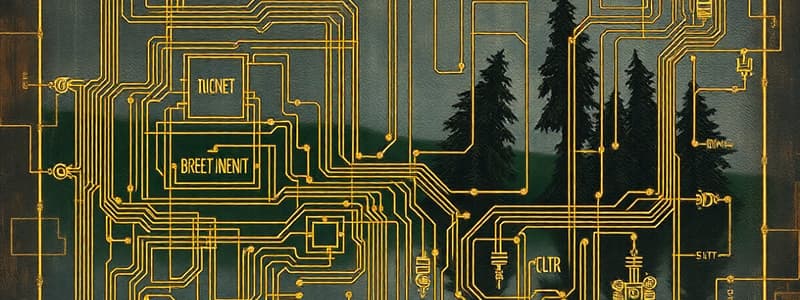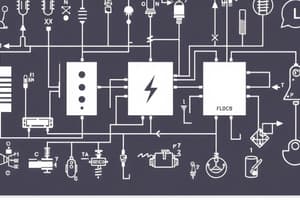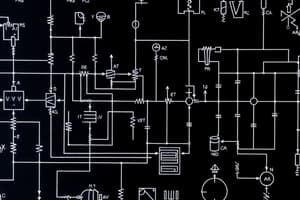Podcast
Questions and Answers
What is the primary function of a fuse in an electrical circuit?
What is the primary function of a fuse in an electrical circuit?
- Provides energy to the circuit
- Completes the circuit to allow current flow
- Melts to stop the flow of electrons when heated (correct)
- Measures the amount of current in the circuit
Which component in a circuit is responsible for producing light?
Which component in a circuit is responsible for producing light?
- Resistor
- Light bulb (correct)
- Ammeter
- Motor
What does a voltmeter measure in an electrical circuit?
What does a voltmeter measure in an electrical circuit?
- The amount of resistance
- The electric potential (correct)
- The amount of current
- The flow of electrons
What is the role of a resistor in an electrical circuit?
What is the role of a resistor in an electrical circuit?
Which of the following correctly describes an open switch in a circuit?
Which of the following correctly describes an open switch in a circuit?
What happens to an object that loses electrons when rubbed with another neutral object?
What happens to an object that loses electrons when rubbed with another neutral object?
In which type of circuit do all components stop working if one component fails?
In which type of circuit do all components stop working if one component fails?
What is the role of a conductor in terms of electron flow?
What is the role of a conductor in terms of electron flow?
What type of current flows in one direction only?
What type of current flows in one direction only?
How is voltage measured in an electrical system?
How is voltage measured in an electrical system?
What voltage is required for a coffee grinder with a resistance of 85.0 Ω and a current of 1.41 A?
What voltage is required for a coffee grinder with a resistance of 85.0 Ω and a current of 1.41 A?
Calculate the current drawn by an electric clothes dryer that is connected to a 230 V source and has a resistance of 9.2 Ω.
Calculate the current drawn by an electric clothes dryer that is connected to a 230 V source and has a resistance of 9.2 Ω.
What is the resistance of a device if a voltage of 110 V causes a current of 10 A?
What is the resistance of a device if a voltage of 110 V causes a current of 10 A?
Given a portable radio using a 9.0 V battery that draws a current of 0.025 A, what is the resistance of the radio?
Given a portable radio using a 9.0 V battery that draws a current of 0.025 A, what is the resistance of the radio?
How much voltage drop occurs across an electrical load with a resistance of 4.0 Ω where a current of 3.0 A flows?
How much voltage drop occurs across an electrical load with a resistance of 4.0 Ω where a current of 3.0 A flows?
What does the term 'Ohm' represent in electrical terminology?
What does the term 'Ohm' represent in electrical terminology?
Which of the following materials has the strongest tendency to gain electrons?
Which of the following materials has the strongest tendency to gain electrons?
What is a basic requirement for a functioning electrical circuit?
What is a basic requirement for a functioning electrical circuit?
When wool is rubbed on a balloon, what happens to the charges?
When wool is rubbed on a balloon, what happens to the charges?
If hair is rubbed against rabbit fur, what is the resulting charge on each?
If hair is rubbed against rabbit fur, what is the resulting charge on each?
What is the voltage across resistor 2 in the first circuit with a 9.0V voltage source and a voltage drop of 3.0V across resistor 1?
What is the voltage across resistor 2 in the first circuit with a 9.0V voltage source and a voltage drop of 3.0V across resistor 1?
In the first circuit, what is the current through resistor 2 if 2.0A is flowing through the circuit?
In the first circuit, what is the current through resistor 2 if 2.0A is flowing through the circuit?
For the second circuit with a 9.0V source, if the current before resistor 2 is 3.0A and it splits with 1.0A going through another resistor, what is the current through resistor 2?
For the second circuit with a 9.0V source, if the current before resistor 2 is 3.0A and it splits with 1.0A going through another resistor, what is the current through resistor 2?
What is the total voltage drop in the second circuit if the voltage source is 9.0V and two different currents are present?
What is the total voltage drop in the second circuit if the voltage source is 9.0V and two different currents are present?
If the voltage across resistor 2 in the second circuit needs to be calculated after knowing the total voltage and the voltages across other resistors, which calculation is appropriate?
If the voltage across resistor 2 in the second circuit needs to be calculated after knowing the total voltage and the voltages across other resistors, which calculation is appropriate?
Which components should be included in a circuit diagram for a circuit consisting of a 2-cell battery, light bulb, and a motor?
Which components should be included in a circuit diagram for a circuit consisting of a 2-cell battery, light bulb, and a motor?
In a circuit with a 1-cell battery, open switch, resistor, and ammeter, what is the correct order of components?
In a circuit with a 1-cell battery, open switch, resistor, and ammeter, what is the correct order of components?
What additional component is necessary in a circuit that includes a 2-cell battery, open switch, fuse, motor, and ground wire?
What additional component is necessary in a circuit that includes a 2-cell battery, open switch, fuse, motor, and ground wire?
What is the total voltage supplied in a circuit with a 3-cell battery that also includes a closed switch, clock, and two light bulbs?
What is the total voltage supplied in a circuit with a 3-cell battery that also includes a closed switch, clock, and two light bulbs?
In a circuit diagram that includes a 2-cell battery, an open switch, a resistor, and an ammeter, what would be the typical output if the switch is closed?
In a circuit diagram that includes a 2-cell battery, an open switch, a resistor, and an ammeter, what would be the typical output if the switch is closed?
What is a key advantage of geothermal energy?
What is a key advantage of geothermal energy?
Which disadvantage is common to both geothermal and nuclear energy?
Which disadvantage is common to both geothermal and nuclear energy?
Which of the following is an advantage unique to tidal energy?
Which of the following is an advantage unique to tidal energy?
What is a major disadvantage of fossil fuels?
What is a major disadvantage of fossil fuels?
How does nuclear energy primarily compare to geothermal energy in terms of carbon emissions?
How does nuclear energy primarily compare to geothermal energy in terms of carbon emissions?
What is one significant disadvantage of hydroelectric power?
What is one significant disadvantage of hydroelectric power?
Which of the following statements about solar energy is true?
Which of the following statements about solar energy is true?
What is a unique advantage of wind power?
What is a unique advantage of wind power?
What is a common disadvantage of biomass energy?
What is a common disadvantage of biomass energy?
What is a major requirement for wind power generation?
What is a major requirement for wind power generation?
Flashcards
Cell
Cell
A component that provides energy to the circuit.
Open switch
Open switch
A component that stops the flow of current in a circuit.
Closed switch
Closed switch
A component that completes the circuit allowing current to flow.
Resistor
Resistor
Signup and view all the flashcards
Voltmeter
Voltmeter
Signup and view all the flashcards
Static electricity
Static electricity
Signup and view all the flashcards
Friction (in static electricity)
Friction (in static electricity)
Signup and view all the flashcards
Grounding
Grounding
Signup and view all the flashcards
Conductor
Conductor
Signup and view all the flashcards
Insulator
Insulator
Signup and view all the flashcards
Ohm's Law
Ohm's Law
Signup and view all the flashcards
Resistance
Resistance
Signup and view all the flashcards
Electric Current
Electric Current
Signup and view all the flashcards
Voltage
Voltage
Signup and view all the flashcards
Voltage Drop
Voltage Drop
Signup and view all the flashcards
Current in a series circuit
Current in a series circuit
Signup and view all the flashcards
Voltage in a series circuit
Voltage in a series circuit
Signup and view all the flashcards
Resistance in a series circuit
Resistance in a series circuit
Signup and view all the flashcards
Current in a parallel circuit
Current in a parallel circuit
Signup and view all the flashcards
Voltage in a parallel circuit
Voltage in a parallel circuit
Signup and view all the flashcards
Fuse
Fuse
Signup and view all the flashcards
Series Circuit
Series Circuit
Signup and view all the flashcards
Parallel Circuit
Parallel Circuit
Signup and view all the flashcards
Renewable Energy
Renewable Energy
Signup and view all the flashcards
Geothermal Energy
Geothermal Energy
Signup and view all the flashcards
Tidal Energy
Tidal Energy
Signup and view all the flashcards
Fossil Fuel Energy
Fossil Fuel Energy
Signup and view all the flashcards
Nuclear Energy
Nuclear Energy
Signup and view all the flashcards
Hydroelectric power
Hydroelectric power
Signup and view all the flashcards
Solar power
Solar power
Signup and view all the flashcards
Wind power
Wind power
Signup and view all the flashcards
Biomass power
Biomass power
Signup and view all the flashcards
Study Notes
Circuit Diagram Symbols
- 2-Cell Battery: Symbol: Two connected battery symbols (+ and -)
- 3-Cell Battery: Symbol: Three connected battery symbols (+ and -)
- Open Switch: Symbol: Two lines connected to a gap.
- Closed Switch: Symbol: Two lines connected with a continuous line.
- Fuse: Symbol: A symbol resembling a small glass tube with a thin wire.
- Light bulb: Symbol : A circle with a filament inside.
- Motor: Symbol : A set of lines in a figure eight configuration.
- Resistor: Symbol : A zig-zag line.
- Ammeter: Symbol: A circle with the letter "A" inside.
- Voltmeter: Symbol: A circle with the letter "V" inside.
- Ground Connection: Symbol: A line extending downwards with an arrowhead.
- Conducting Wire: Symbol: A straight line.
Circuit Functions
- Battery: Provides energy to the circuit, producing an electric potential difference.
- 2-Cell or 3-Cell Battery: Provides energy to the circuit, producing an electric potential difference.
- Open Switch: Stops the current flow, making the circuit inactive.
- Closed Switch: Completes the circuit so that it works.
- Fuse: Will melt and stop the flow of electrons when heated to high temperatures, protecting the circuit from excessive current.
- Light bulb: Produces light and converts electrical energy to light and heat energy.
- Motor: Slows down the flow of current and converts electrical energy to mechanical energy.
- Resistor: Slows the flow of electrons in a circuit and helps control the flow; converts electrical energy into other forms of energy like heat and sound.
- Ammeter: Measures the amount of current flowing through a part of a circuit.
- Voltmeter: Measures electric potential difference (voltage) between two points in a circuit.
- Ground Connection: Connects circuits to the ground, removing excess electric charges.
- Conducting Wire: Connects parts of the circuit, facilitating the flow of electrons.
Studying That Suits You
Use AI to generate personalized quizzes and flashcards to suit your learning preferences.



